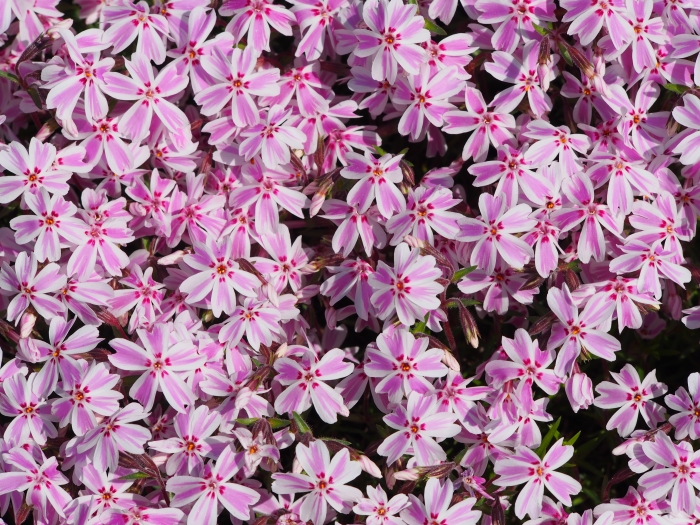Creeping Phlox
(Phlox subulata)
Creeping Phlox (Phlox subulata)
/
/

Agnieszka Kwiecień, Nova
CC BY-SA 4.0
Image By:
Agnieszka Kwiecień, Nova
Recorded By:
Copyright:
CC BY-SA 4.0
Copyright Notice:
Photo by: Agnieszka Kwiecień, Nova | License Type: CC BY-SA 4.0 | License URL: https://creativecommons.org/licenses/by-sa/4.0 | Uploader: Nova | Publisher: Wikimedia Commons | Title: Phlox_subulata_'Tamaongalei'_Floks_szydlasty_2017-05-01_02.jpg | Notes: User created page with UploadWizard |







































































Estimated Native Range
Summary
Phlox subulata, commonly known as creeping phlox, moss phlox, moss pink, or mountain phlox, is an evergreen perennial herb native to open woodlands and slopes in eastern and central USA. It forms dense ground-covering mats reaching about 13 cm (5 in) in height and spreading up to 50 cm (20 in) wide. The foliage consists of hairy, linear leaves that create a cushion-like appearance. From late spring to early summer, it produces a profusion of small, five-petaled flowers in shades of rose, mauve, blue, white, or pink, which are highly attractive to pollinators such as butterflies.
Creeping phlox is valued for its vibrant floral display and its ability to form a dense carpet, making it an excellent choice for front-of-border displays, rock gardens, and as a ground cover to prevent soil erosion. It thrives in full sun and well-drained soil, and while it is drought-tolerant once established, it benefits from regular watering during prolonged dry spells. It is hardy to USDA zones 3 to 9 and can tolerate temperatures down to −20 °C (−4 °F). This plant is relatively low-maintenance, but it can be susceptible to foliar diseases in humid conditions. To maintain its compact form and encourage a second bloom, it can be lightly sheared back after flowering.CC BY-SA 4.0
Creeping phlox is valued for its vibrant floral display and its ability to form a dense carpet, making it an excellent choice for front-of-border displays, rock gardens, and as a ground cover to prevent soil erosion. It thrives in full sun and well-drained soil, and while it is drought-tolerant once established, it benefits from regular watering during prolonged dry spells. It is hardy to USDA zones 3 to 9 and can tolerate temperatures down to −20 °C (−4 °F). This plant is relatively low-maintenance, but it can be susceptible to foliar diseases in humid conditions. To maintain its compact form and encourage a second bloom, it can be lightly sheared back after flowering.CC BY-SA 4.0
Plant Description
- Plant Type: Subshrub, Herb
- Height: 0.3-0.5 feet
- Width: 1-2 feet
- Growth Rate: Rapid
- Flower Color: Pink, Purple, White
- Flowering Season: Spring
- Leaf Retention: Evergreen
Growth Requirements
- Sun: Full Sun, Part Shade
- Water: Low
- Drainage: Medium
Common Uses
Bee Garden, Bird Garden, Butterfly Garden, Fragrant, Groundcover, Hummingbird Garden, Low Maintenance, Rock Garden, Showy Flowers, Street Planting
Natural Habitat
Open woodlands and slopes
Other Names
Common Names: Moss Phlox, Moss Pink, Mountain Phlox, Polster-Phlox, Sammalleimu, Vårfloks, Mossflox
Scientific Names: , Phlox subulata, Phlox subulata var. subulata, Phlox subulata f. albiflora, Phlox subulata subsp. eusubulata, Phlox subulata f. candidula, Phlox subulata f. subulata, Phlox subulata var. latifolia,
GBIF Accepted Name: Phlox subulata L.